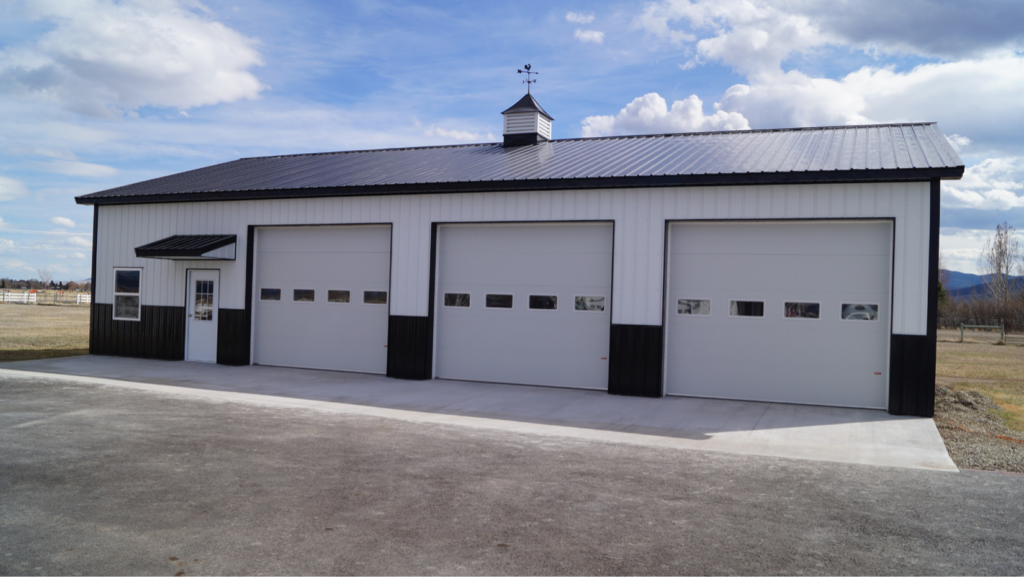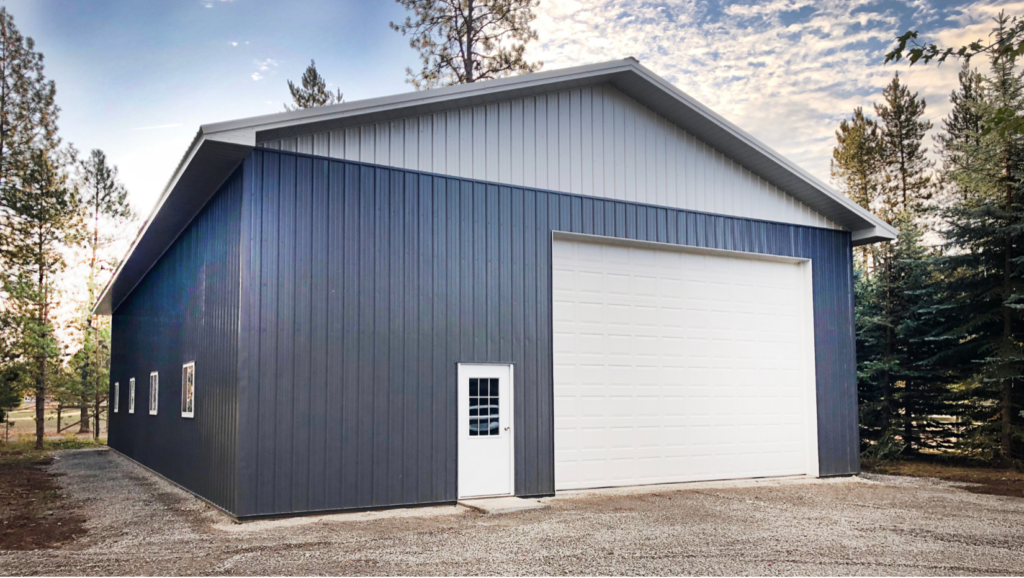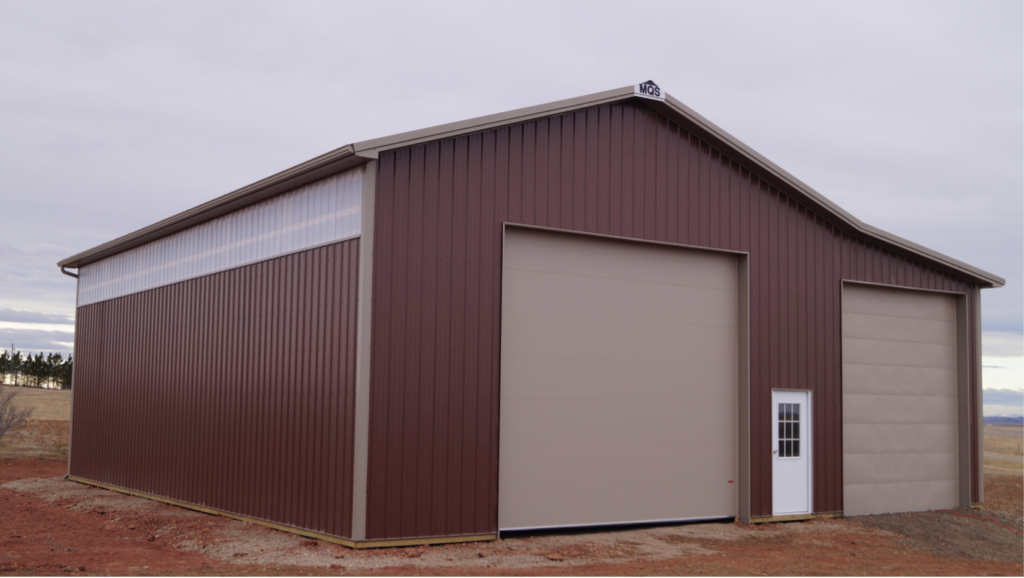Efficient drainage around post-frame metal buildings in Wyoming is imperative to protect the integrity of your structure and the value of your property. Whether you’re a farmer, building contractor, landowner, small business owner, or homeowner, implementing effective drainage strategies can mitigate water damage risks and prolong the lifespan of your building. Here are 18 methods tailored to maximize drainage efficiency around your post frame steel buildings in Wyoming.
- 1. Build Your Post-Frame Metal Buildings in Wyoming on High Ground
- 2. Add Gutters and Downspouts
- 3. Add a French Drain
- 4. Install a Driveway to Your Post-Frame Metal Buildings in Wyoming
- 5. Install Sidewalks
- 6. Add Porches to Your Post-Frame Metal Buildings in Wyoming
- 7. Don’t Plant Landscaping Too Close to Your Building
- 8. Dig Ditches - Post-Frame Metal Buildings in Wyoming
- 9. Install Culverts Under Driveways if Applicable
- 10. Create Swales
- 11. Elevate the Building Foundation Before the Construction of Your Post-Frame Metal Buildings in Wyoming
- 12. Grade the Perimeter
- 13. Use Retaining Walls
- 14. Incorporate Permeable Paving Around Post-Frame Metal Buildings in Wyoming
- 15. Utilize Rain Barrels
- 16. Install a Dry Well
- 17. Landscape with Drainage in Mind - Post-Frame Metal Buildings in Wyoming
- 18. Regular Maintenance Is Essential for Custom Pole Barns in Wyoming
- MQS Barn – Steel Buildings in Wyoming
1. Build Your Post-Frame Metal Buildings in Wyoming on High Ground
Positioning your barn or building on elevated terrain facilitates natural water flow away from the structure. This geographical advantage minimizes water pooling around the foundation, significantly reducing the risk of water damage. Always assess the topography before construction and opt for higher ground when possible.
2. Add Gutters and Downspouts
Gutters redirect rainwater from your roof away from the building’s foundation. Ensure gutters are correctly installed along the roof perimeter and connected to downspouts that channel water at least 10 feet from the building. Regular cleaning and maintenance of gutters and downspouts are essential to prevent blockages that can lead to overflow.

3. Add a French Drain
A French drain is a trench filled with gravel or rock containing a perforated pipe that directs surface water and groundwater away from the building. It’s an effective solution to enhance sub-surface drainage, especially in areas prone to water accumulation. Position the French drain along the perimeter of your building where water tends to collect.
4. Install a Driveway to Your Post-Frame Metal Buildings in Wyoming
A properly graded driveway not only provides access to your building but also directs water flow. Use materials such as gravel, concrete, or asphalt for durability and ensure a slight slope away from the building to facilitate drainage. A well-constructed driveway acts as a barrier, redirecting water from critical areas.
5. Install Sidewalks
Sidewalks serve a similar purpose to driveways, offering pedestrians a path while acting as additional water barriers. Ensure sidewalks have appropriate grading to prevent water pooling and direct runoff from your building. Strategic placement of sidewalks can effectively channel water to desired drainage points.
6. Add Porches to Your Post-Frame Metal Buildings in Wyoming
Porches not only enhance the aesthetic appeal of a building but also contribute to drainage control. The roof over the porch intercepts rainwater, which can be collected by gutters and diverted away. Raising the porch above ground level can also prevent water from creeping into the building.
7. Don’t Plant Landscaping Too Close to Your Building
While landscaping can beautify the surroundings, plants too close to the structure can hinder drainage. Roots can obstruct and damage underground drainage systems, and dense foliage can trap moisture against the building. Maintain a suitable distance between your building and landscaping to ensure adequate water flow.
8. Dig Ditches – Post-Frame Metal Buildings in Wyoming
Strategically placed ditches can act as channels to convey water away from your building. These should be carefully positioned to catch runoff and direct it to a safe discharge area. The slope of the ditches is crucial; they must be inclined enough to allow water to flow but not erode the ditch.
9. Install Culverts Under Driveways if Applicable
In situations where driveways cross over natural drainage paths, installing culverts becomes necessary. Culverts allow water to pass underneath the driveway, preventing obstruction of the natural water flow. Ensure culverts are of appropriate diameter to handle peak water volumes and are installed with proper gradients.
10. Create Swales
Swales are shallow, vegetated channels designed to slow and capture runoff. They can be integrated into landscaping around your building to enhance aesthetics while improving surface water management. Swales divert water away and encourage infiltration, replenishing groundwater supplies.

11. Elevate the Building Foundation Before the Construction of Your Post-Frame Metal Buildings in Wyoming
Elevate the foundation of your building above the natural grade to prevent water from seeping into the structure. This can be accomplished by using compacted-fill soil or constructing a raised foundation. Such elevation ensures water flow is directed away from the building, even during heavy rainfall.
12. Grade the Perimeter
Ensure that the ground immediately surrounding your building slopes away from the foundation. A 5% grade (or a slope of 6 inches over 10 feet) is typically sufficient to guide water away effectively. This is one of the simplest yet most effective strategies to prevent water from pooling around the building.
13. Use Retaining Walls
In areas with significant slope variations, retaining walls can be instrumental in managing runoff. They prevent soil erosion while creating flat areas where water is less likely to gather. Properly constructed retaining walls also offer an opportunity to include additional drainage solutions like weep holes or drainage pipes.
14. Incorporate Permeable Paving Around Post-Frame Metal Buildings in Wyoming
Permeable paving materials allow rainwater to filter through the ground beneath, reducing runoff and encouraging natural groundwater recharge. Options include permeable concrete, porous asphalt, and paving stones set with gaps. This method is particularly useful in parking areas and walkways surrounding the building.
15. Utilize Rain Barrels
Rain barrels are a simple yet effective way to collect and store rainwater from downspouts for future use. By capturing rainwater, you reduce the immediate volume of water flowing around the building, mitigating potential drainage issues. The stored water can later be used for irrigation, making this a sustainable solution.
16. Install a Dry Well
A dry well is an underground structure that collects and disperses water deep into the earth. It’s beneficial in areas with poor surface drainage or other methods are not feasible. By directing water away effectively, a dry well prevents accumulation and saturation around your building.

17. Landscape with Drainage in Mind – Post-Frame Metal Buildings in Wyoming
Choose plants and landscaping elements that aid drainage, such as deep-rooted plants that help soil absorb water. Design your landscaping layout to guide runoff away from the building using graded beds and strategic plant placement. Thoughtful landscaping can be beautiful and functional, providing natural solutions to drainage challenges.
18. Regular Maintenance Is Essential for Custom Pole Barns in Wyoming
No drainage solution remains effective without regular maintenance. Keep gutters, downspouts, ditches, and drains clear of debris to ensure they function as intended. Seasonal inspections and clean-ups can prevent minor issues from becoming major problems, ensuring the long-term efficiency of your drainage systems.
MQS Barn – Steel Buildings in Wyoming
We have you covered if you want a new garage in Wyoming, a new barn, or a workshop. When you are ready to start, we can work with you to ensure you get the barn you need.
MQS is a family-owned and operated company specializing in post-frame, steel-sided structures, and agricultural buildings in Wyoming. Are you looking for Amish pole barn builders in Wyoming? The co-founder and co-owner of MQS Barn, Mark Stoltzfus, began his building career with his Amish Mennonite family and applies the same work ethic and expert craftsmanship on every project we do.

Call us today at 855-677-2276, or contact us online to receive a free quote on your next project. We look forward to hearing from you soon!
